Milestone in Neurobiological Research: Mapping the Fruit Fly Brain
Scientists have mapped the entire brain of an adult fruit fly, unveiling over 50 million connections among 139,000 neurons. This groundbreaking research could provide insights into brain functions across species, including humans. The study was published in Nature and involved a large international team called the FlyWire Consortium.

Scientists announced a remarkable breakthrough in neurobiological research on Thursday, achieving a comprehensive mapping of the adult fruit fly brain. This feat, detailed in the journal Nature, may offer crucial insights into brain functions across the animal kingdom, including humans.
The research unveiled an intricate network of more than 50 million connections among 139,000 neurons, the brain's nerve cells, in the insect species Drosophila melanogaster. Comprehensive mapping, also known as connectomics, has been previously performed on simpler organisms, but the adult fruit fly presented more complex behaviors to study. "Understanding any brain can shed light on how all brains function," said Sebastian Seung, a Princeton University professor and co-leader of the study.
By meticulously mapping the fly brain, the team identified numerous neural circuits and behaviors, including walking, feeding, and social interactions. This international endeavor, named the FlyWire Consortium, has set a new standard in neurobiological research and paves the way for future studies on other species.
(With inputs from agencies.)










